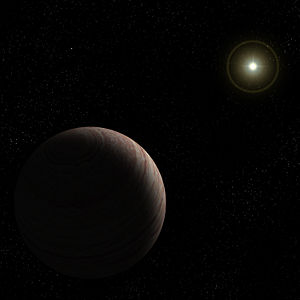
47 Ursae Majoris b
About this schools Wikipedia selection
This Wikipedia selection is available offline from SOS Children for distribution in the developing world. SOS Children works in 45 African countries; can you help a child in Africa?
| Extrasolar planet | List of extrasolar planets | |
|---|---|---|
 |
||
| Parent star | ||
| Star | 47 Ursae Majoris | |
| Constellation | Ursa Major | |
| Right ascension | (α) | 10h 59m 28.0s |
| Declination | (δ) | +40° 25′ 49″ |
| Distance | 45.9 ly (14.1 pc) |
|
| Spectral type | G1V | |
| Orbital elements | ||
| Semimajor axis | (a) | 2.11 ± 0.04 AU |
| Eccentricity | (e) | 0.049 ± 0.014 |
| Orbital period | (P) | 1083.2 ± 1.8 d |
| Time of periastron | (T0) | 2,450,173 ± 65 JD |
| Semi-amplitude | (K) | 49.3 ± 1.0 m/s |
| Physical characteristics | ||
| Mass | (m) | >2.60 ± 0.13 MJ |
| Discovery information | ||
| Discovery date | Jan 17, 1996 | |
| Discoverer(s) | Marcy, Butler et al. | |
| Detection method | Doppler Spectroscopy | |
| Discovery site | California, United States | |
| Discovery status | Confirmed | |
47 Ursae Majoris b is an extrasolar planet orbiting the Sun-like star 47 Ursae Majoris. It is located in a long- period, near-circular orbit and is the innermost known planet in its planetary system. 47 Ursae Majoris b was discovered in Jan 1996 and has a mass at least 2.63 times that of Jupiter.
Discovery
Like the majority of known extrasolar planets, 47 Ursae Majoris b was discovered by detecting the changes in its star's radial velocity as the planet's gravity pulls the star around. This was achieved by observing the Doppler shift of the spectrum of 47 Ursae Majoris. After the discovery of the first extrasolar planet around a Sun-like star, 51 Pegasi b, astronomers Geoffrey Marcy and R. Paul Butler searched through their observational data for signs of extrasolar planets and soon discovered two: 47 Ursae Majoris b and 70 Virginis b. The discovery of 47 Ursae Majoris b was announced in 1996.
Orbit and mass
47 Ursae Majoris b orbits at a distance of 2.11 AU from its star, taking 1,083 days to complete a revolution. It was the first long-period planet around a main sequence star to be discovered. Unlike the majority of known long-period extrasolar planets, the eccentricity of the orbit of 47 Ursae Majoris b is low.
A limitation of the radial velocity method used to detect 47 Ursae Majoris b is that only a lower limit on the planet's mass can be obtained. Preliminary astrometric measurements made by the Hipparcos satellite suggest the planet's orbit is inclined at an angle of 63.1° to the plane of the sky, which would imply a true mass 12% greater than the lower limit determined by radial velocity measurements. However, subsequent investigation of the data reduction techniques used suggests that the Hipparcos measurements are not precise enough to adequately characterise the orbits of substellar companions, and the true inclination of the orbit (and hence the true mass) are regarded as unknown.
Characteristics
Given the planet's high mass, it is likely that 47 Ursae Majoris b is a gas giant with no solid surface. Since the planet has only been detected indirectly, properties such as its radius, composition and temperature are unknown. Due to its mass it is likely to have a surface gravity 6-8 times that of Earth. Assuming a composition similar to that of Jupiter and an environment close to chemical equilibrium, the upper atmosphere of the planet is expected to contain water clouds, as opposed to the ammonia clouds typical of Jupiter.
While 47 Ursae Majoris b lies outside its star's habitable zone, its gravitational influence would disrupt the orbit of planets in the outer part of the habitable zone. In addition, it may have disrupted the formation of terrestrial planets and reduced the delivery of water to any inner planets in the system. Therefore planets located in the habitable zone of 47 Ursae Majoris are likely to be small and dry.
